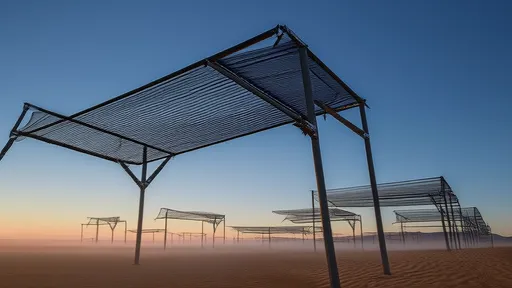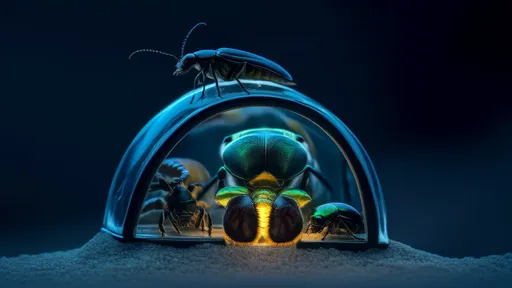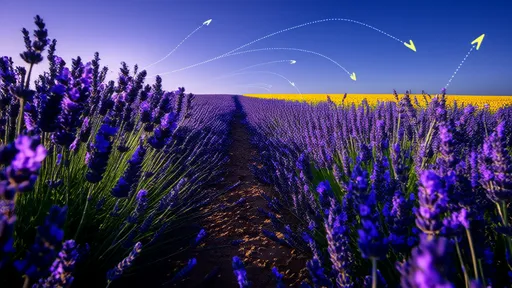In the arid expanse of Chile's Atacama Desert, where rainfall is nearly nonexistent and water scarcity defines daily life, an ingenious solution has emerged from the intersection of ancient wisdom and modern innovation. The fog-harvesting nets, known locally as "atrapanieblas," stand as silent sentinels against the relentless dryness, transforming mist into life-sustaining water. These sprawling mesh structures, often stretching across valleys like ghostly sails, have become both a practical resource and a symbol of human adaptability in one of Earth's harshest environments.
The concept behind these fog collectors is deceptively simple yet profoundly effective. As coastal fog—called "camanchaca" by indigenous communities—rolls inland from the Pacific Ocean, the specialized nets intercept its microscopic water droplets. The mesh, typically made from fine polypropylene or nylon fibers, acts as a three-dimensional trap. When wind pushes fog through the netting, droplets accumulate on the fibers, growing heavier until gravity pulls them downward into collection troughs. A single square meter of mesh can yield up to 14 liters of water daily during peak fog seasons, with some large installations providing thousands of liters for nearby villages.
What makes Chile's fog-harvesting systems remarkable isn't just their engineering, but their cultural resonance. The technique echoes pre-Columbian practices where indigenous groups placed ceramic pots beneath trees to collect dripping fog condensation. Today's installations often incorporate community participation in their construction and maintenance, creating a tangible connection between modern technology and ancestral knowledge. Researchers from the Pontifical Catholic University of Chile have refined the mesh designs over decades, experimenting with fiber density, coating treatments, and structural configurations to maximize water capture while withstanding the desert's punishing UV radiation and occasional sandstorms.
The geographical positioning of these fog catchers reveals an elegant understanding of microclimates. Most installations cluster along the coastal mountain range between 600-1,200 meters elevation, where the Humboldt Current's cold waters collide with warmer air to create persistent fog banks. The town of Chungungo serves as a flagship example—once dependent on expensive water truck deliveries, it now sources about 15,000 liters daily from a hillside array of 94 fog collectors. This system, installed in the 1990s, demonstrated the technology's viability at community scale and inspired similar projects across Latin America's arid regions.
Maintenance presents unexpected challenges that blend mundane practicality with ecological sensitivity. The same microscopic pores that efficiently capture water droplets also trap airborne dust and salt particles, requiring regular cleaning with non-potable water to prevent clogging. Engineers have developed bio-inspired coatings that mimic the water-repellent properties of beetle shells or cactus spines to improve droplet runoff. Meanwhile, biologists monitor the nets' environmental impact, as the collected fog water would naturally sustain certain desert ecosystems. Striking this balance between human needs and environmental stewardship remains an ongoing conversation among researchers and community leaders.
Recent technological advancements are pushing fog harvesting into new frontiers. Some experimental systems now integrate solar-powered sensors to track moisture accumulation and wind patterns in real time, allowing remote adjustment of panel angles for optimal capture. Other prototypes explore biomimetic designs, including fibers that replicate the water-channeling nanostructures found in spider silk or desert grasses. Perhaps most promising are hybrid systems that combine fog harvesting with atmospheric water generators, creating redundant water sources for critical applications like hospitals and schools.
The social impact of these projects often outweighs their quantitative water output. In villages where women and children previously spent hours daily fetching water from distant wells, the fog nets have redistributed labor and created educational opportunities. Some communities have developed small-scale agricultural projects using the harvested water, growing everything from quinoa to medicinal herbs in protected greenhouses. The nets have also become cultural landmarks, featured in local art installations and youth environmental education programs that frame water conservation as both a technological challenge and a collective responsibility.
As climate change intensifies aridification across subtropical regions, Chile's fog-harvesting experience offers valuable lessons. While not a panacea for global water scarcity—fog collection requires specific meteorological conditions—the principles of low-tech, high-efficiency water capture translate well to other contexts. From the water-stressed Canary Islands to drought-plagued California, variations on the Atacama's fog nets are being adapted to local conditions. The true innovation may lie not in the technology itself, but in its demonstration of how human ingenuity can work with natural systems rather than against them.
Looking ahead, researchers envision next-generation fog harvesters that integrate with renewable energy microgrids and desalination systems, creating resilient water networks for vulnerable communities. The Atacama's mesh arrays, once seen as experimental curiosities, now stand as proven infrastructure—their droplets telling a larger story about sustainability in an increasingly thirsty world. In these vertical nets that drink from the air, we find hope that even in Earth's driest places, water can be coaxed from the unseen.

By /Jul 16, 2025

By /Jul 16, 2025

By /Jul 16, 2025

By /Jul 16, 2025

By /Jul 16, 2025

By /Jul 16, 2025

By /Jul 16, 2025

By /Jul 16, 2025

By /Jul 16, 2025

By /Jul 16, 2025

By /Jul 16, 2025

By /Jul 16, 2025

By /Jul 16, 2025

By /Jul 16, 2025

By /Jul 16, 2025

By /Jul 16, 2025

By /Jul 16, 2025

By /Jul 16, 2025